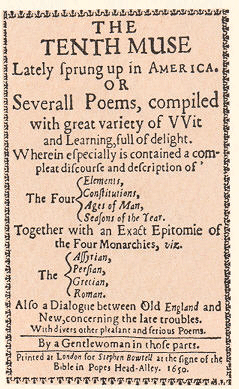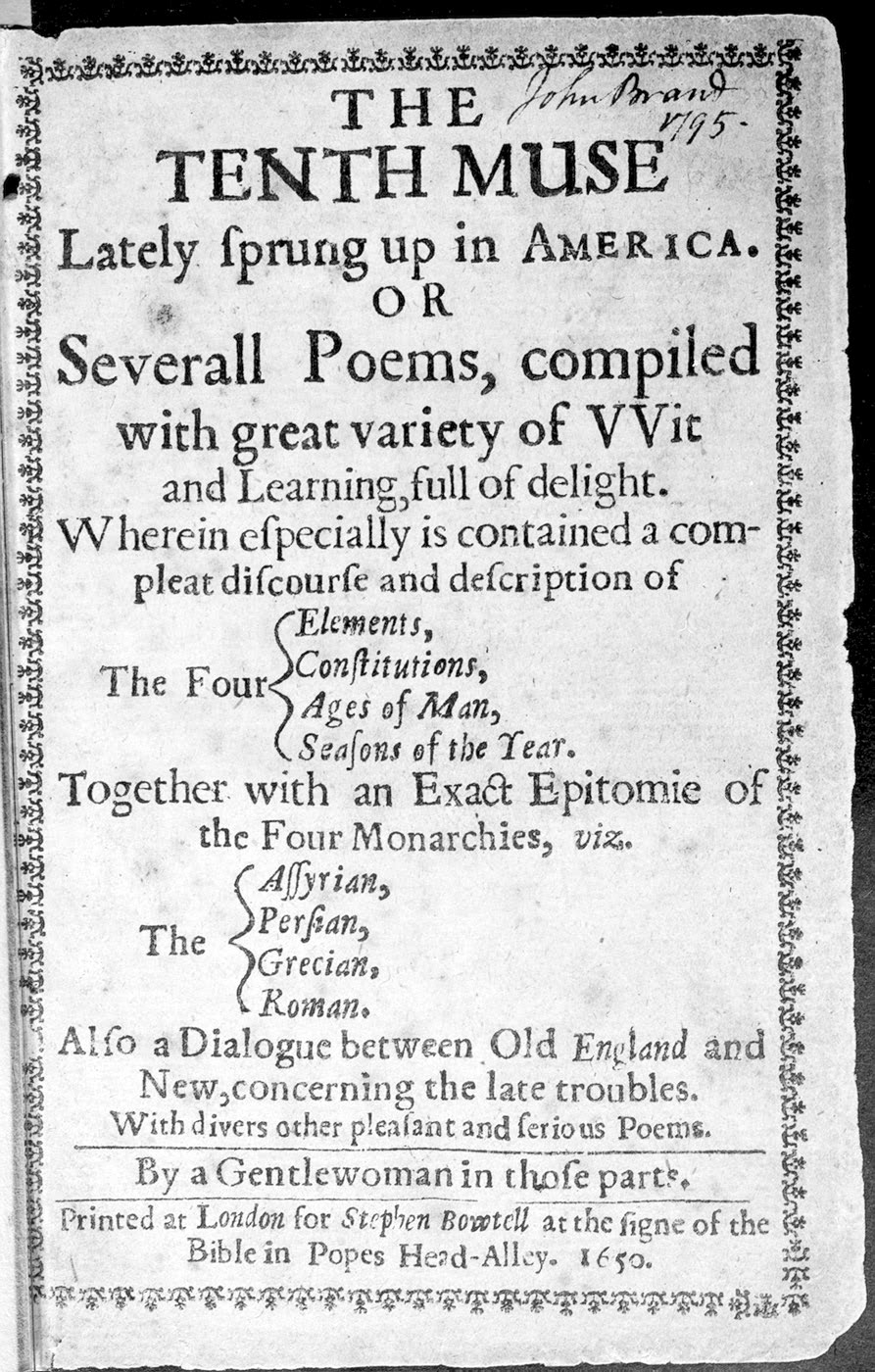Course Links
Lesson Plans
Course Documents
Links
Secondary Sources
Quick Links
Library Links
Citing Sources
|
Terms | Life | Times | Class Discussion | Group Questions | Links | Pictures | Quotes from Critics
http://upload.wikimedia.org/wikipedia/commons/2/29/The_Tenth_Muse_by_Anne_Bradstreet.jpg |
![]()
Terms and People to Know
Devotional Poetry: Poetry written to praise a religious figure or profess a religious belief
Metaphysical Poetry: Common during the 17th century, it is poetry which delights in developing extended metaphors, usually between seeming disparate objects - i.e. love and a compass (Donne's "A Valediction Forbidding Mourning"
John Donne: Best known metaphysical poet (English, 1572?-1631)
Conceit: in poetry a particular extended metaphor, usually employed to convey a complex thought.
Jeremiad : A rhetorical style which preaches hell and damnation because of the sinfulness of its audience. Usually a sermon, but this could be in a novel, poem, or other work. It could also be secularized as a more warning for any kind of dire future because of the apathy/ignorance/indolence of its audience.
![]()
Life
Below you'll find a short (8 min.) radio story on Bradstreet from National Public Radio -- A great example of your tax dollars at work.
Anne Bradstreet: America's First Poet
![]() This may take a moment to load into Windows Media
This may take a moment to load into Windows Media
Weekend Edition - Saturday , April 23, 2005 · Anne Bradstreet was a reluctant settler in America, a Puritan who migrated from her beloved England in the 1600s. She became America's first poet, and a new biography details her life. Scott Simon speaks with poet Charlotte Gordon, author of Mistress Bradstreet: The Untold Life of America's First Poet . (8 min. long)
Note her education - she knew Greek and Latin and was well educated -- and her birthplace --she came over as a young bride.
She is more accomplished as a poet than other puritan writers -- writes well in a variety of forms: meditation, lyric, occasional poetry, epic, elegy,
![]()
Times
Repeated from previous lesson plans . . .
Two links below: the first is more historical, the second is more literary. they should be considered as a supplement to the overview on the period included in your textbook.
Puritanism The Oxford Companion to United States History
Puritanism: The Sense of an Unending: From the Oxford Encyclopedia of American Literature This has a particularly good bibliography.
![]()
Connections b/t poets
- How does poetry connect with Puritanism? Is it successful? I.e. do these work both as poems and as puritan documents?
- What in these poems make them "puritan"?
- How do these connect with the prose we've read (this may be similar to previous question -- make specific connections of specific words in poems to specific words in prose)
"The Author to Her Book"
- What rag is she referring to in line 5?
- What is she suggesting about her verse in line 17-18? What kind of "dress" is she referring to?
"The Prologue"
- What does this poem reveal about the role of women in Puritan life?
- Why would she include it as a prologue?
- OED "obnoxious"
- Irony? Sarcasm?
"Contemplations"
- What's the definition of contemplation
- This poem fits into the 17 th century view of meditative poetry which typically followed a three part pattern: "memory, understading, and will. In the first part, the person creates or recalls a scene; in the second part, he analyzes its spiritual significance; and last, he responds emotionally and intellectually by prayer and devotion" (Derounian 322) from Magill
- Stanza 1-2 connect nature to who? What would Bradford say about this? What would Morton?
- Why move from thoughts of nature/god?
- Why bring up Adam and Eve and Cain and Abel?
- Stanza 21 moves from rocks and trees to water and fish as locus
- Where is she drawing her allusions from?
- Stanza 26 shift to birds
- What contrast is set up in stanzas 26-28 and then 29? Who seems to "win" this contrast by the end of stanza 29? Who wins by stanza 30? Why?
- On one level the poem is about time -- why? Why meditate on time -- what's the connection to religion?
- Seems mixed on nature -- she calls "Time, the fatal wrack of mortal things" yet argues earlier that nature itself will last -- I guess she implies that only God will last forever, but it does seem that nature will be around for quite a while as well.
Scheick, William J. "Early Anglo-American Poetry: Genre, Voice, Art, and Representation." Teaching the Literatures of Early America . Ed. Carla Mulford. New York : MLA, 1999. 187-199. Print.
"Emblems [ . . .] are concrete instance of how Puritans read nature as liber mundi (creation as a divinely inspired text that reiterates Scripture). Emblems tend to have layers of signification, and so students with some knowledge of the Bible might be encouraged to think further about verticality (the trees) and horizontalness (the river) in "Contemplations." IN this poem, with the same number o stanzas as Christ's age at his crucifiction, the two natural types of river and trees emblematically suggest th intersection of the divine (eternal) and the human (temporal) on Christ's cross (Scheick)" (Scheick 189)
"Here Follows"
- What's the central metaphor in this poem? Does it work?
- Why "blest" god for burning a house?
- What's the difference b/t "pleasant" (lines 27, 31) and the house in heaven?
"To My Dear and Loving Husband"
- How is his work different from Bradstreet's
"Meditation 8 "
- What metaphysical conceit does he develop throughout the poem? ____ is _____
- What is the "Bread of Life" that he is talking about?
"Huswifery" (360)
- How effective is the spinning metaphor? How does Edwards develop it?
"A Fig for Thee, Oh! Death" (361)
- how does he describe death in the first few lines? Why?
- What worms is he talking about in line 14/15?
- Why is the body a "harlot" (line 24)?
- Why are "eating and drinking . . . evil joys" (line 26)?
- Who's the "strumpet" (line 29)?
- Which other puritan writer comes to mind in line 37?
![]()
![]()

![]()
Hutson, Matthew. "Are Americans Still Puritan?" New York Times. 3 August 2012.
![]()
© 2009 David Bordelon
